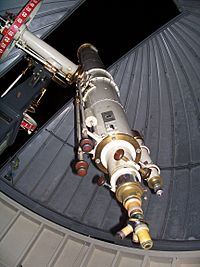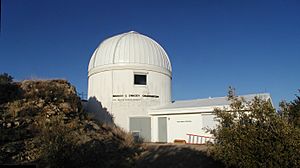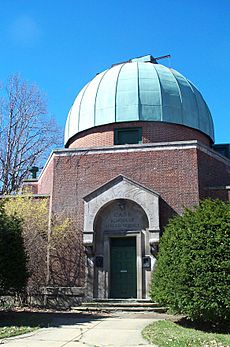Warner and Swasey Observatory facts for kids
Quick facts for kids Warner and Swasey Observatory |
|||||||
|---|---|---|---|---|---|---|---|

The rooftop telescope with the dome open
|
|||||||
| Organization | Case Western Reserve University | ||||||
| Location | Cleveland, Ohio (USA) | ||||||
|
Coordinates
|
41°32′10″N 81°34′6.5″W / 41.53611°N 81.568472°W
|
||||||
|
|||||||
The Warner and Swasey Observatory is a special place where people study the stars. It belongs to Case Western Reserve University. This observatory is named after Worcester R. Warner and Ambrose Swasey. They built it in the early 1900s.
The first observatory was in East Cleveland, Ohio. It had a 9.5-inch (24 cm) refractor telescope. In 1919, it was given to the Case School of Applied Science. Later, a bigger 24-inch (61 cm) Burrell Schmidt telescope was added in 1939.
Over time, too much light pollution from Cleveland made it hard to see the stars clearly. So, in the 1950s, a new station was built in Geauga County. This new place was called Nassau Station. The Burrell telescope was moved there first. Later, it moved again to Kitt Peak National Observatory. Nassau Station then got a 36-inch robotic telescope. In 2008, Nassau Station became part of Observatory Park.
Today, the observatory still uses the old 9.5-inch refractor. It is now called the rooftop telescope and is on the university's main campus. The Burrell Schmidt telescope is at Kitt Peak National Observatory in Arizona. The first observatory building in East Cleveland was sold in 1983.
Contents
History of the Observatory
The Warner and Swasey Observatory was first built by Worchester R. Warner and Ambrose Swasey. They owned a company that made precise tools and telescopes. They were also important people at the Case School of Applied Science.
They built the observatory in East Cleveland. In 1919, they gave it to the school. The building was officially opened in 1920. It was about four miles east of the university campus. The observatory started with a 9.5-inch refractor telescope. Over the years, it grew to have more telescopes and a library. It even had a hall for public talks about space. The 24-inch Burrell Schmidt telescope was one of the new additions.
By the 1950s, the bright lights from Cleveland made it hard to do serious star research. So, a new site was built 30 miles east in Geauga County. This new place is known as the Nassau Station. The Burrell Schmidt telescope was moved there. To make up for this, a 36-inch telescope was put at the East Cleveland site.
In 1978, the Astronomy Department decided to build a new home for the Burrell Schmidt telescope. This new home would be at Kitt Peak National Observatory in Arizona. The telescope moved from Ohio to Arizona in May 1979. In 1980, the 36-inch reflector from East Cleveland was moved to Nassau Station. This meant no more astronomy work happened at the original East Cleveland building.
The observatory's staff and resources moved to the main university campus in 1982. The old East Cleveland building was sold in 1983. It was not used for many years.
Amazing Telescopes

Burrell Schmidt Telescope
The 24-inch Burrell Schmidt Telescope was built in 1939. It was made by the Warner & Swasey Company in Cleveland, Ohio. It first lived at the East Cleveland observatory. Now, it is at Kitt Peak National Observatory near Tucson, Arizona.
This telescope recently got new parts. It now has a special camera called a CCD array. This camera can see a very wide area of the sky. It is much better than the old photographic plates. Case astronomers use this telescope today for their research.
Nassau Station Robotic Observatory
The Nassau Station was built in the 1950s. It now has a 36-inch reflecting telescope. It is named after Jason John Nassau, who was a famous astronomer. In the 1990s, the telescope was updated. It could then be controlled from far away. This made it one of the first telescopes to work like that.
However, astronomers did not use it much. This was because of more light pollution from Cleveland. Also, the Burrell Schmidt telescope became even better. So, the Nassau Station was not used for several years. In 2008, it was sold to the Geauga Park District. The park opened it to the public on June 16, 2012. This park is now a "dark sky park." This means it is a great place to see the stars.
Rooftop Telescope
The Rooftop Telescope is a 9.5-inch refractor. It was built in 1894 by Warner and Swasey for their own use. This telescope was the first instrument at the Warner and Swasey Observatory. It was first used at the East Cleveland site.
When the Astronomy Department moved, the telescope was put away. In 1986, it was put back in a new dome. This dome is on the roof of the A. W. Smith building on the main campus. The telescope is still in great shape today. Students, teachers, and staff can use it. They just need to learn how to use it safely. The university's Physics and Astronomy Club also uses it. They often host public viewing nights.
Discoveries and Research
Scientists using the Warner and Swasey Observatory have made important discoveries. For example, in 1949, Jason Nassau studied carbon stars and M-type stars. More recently, in 2003, the Burrell Schmidt telescope helped find a new galaxy. This galaxy is called Andromeda VIII.
Andromeda VIII orbits the famous Andromeda Galaxy. It was hard to find before because it was hidden in front of the bright part of the Andromeda Galaxy. The Burrell Schmidt telescope has also been used to take pictures of "intracluster light." This light is found in the Virgo Cluster. It is very, very faint, about a thousand times dimmer than the night sky. Scientists combined seventy pictures from the Burrell Schmidt telescope to see it.
See also
 In Spanish: Observatorio Warner y Swasey para niños
In Spanish: Observatorio Warner y Swasey para niños



